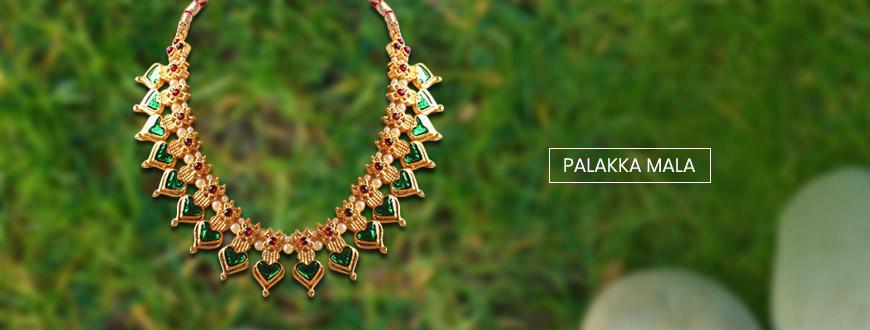Kalyan Wiki

palakka mala
Our typical extravagant wedding ceremony mostly starts with decking up the bride, head to toe in the finery of silk and gold. A traditional Kerala Hindu bride usually wears a 'Settu mundu', a two-piece cotton handwoven saree with thick gold borders. To add lustre to this ensemble, the gold ornaments come in. And the set can include styles ranging from the 'ilakkathali', the 'mullamuttu maala', the three-layer brooch chains, the 'kaashumala', the 'poothali' and many more, but the stand out piece of all is the 'palakka mala'.
The construction
The Palakka maala is speculated to be first worn during the Dwapara Yuga of Shree Krishna. The necklace is distinct in its leaf-shaped lockets, with emerald green inlays set on a heavy gold base. The necklace's centre has a bigger pendant, usually round with gold beads hanging, to define the shape. The palakka mala also has a couple of smaller rubies to make a subtle contrast on the green and balance the colour. The chain derives its name from the 'paala' tree, and its green leaves are rendered in glass or crystals. The elaborate inlays are set in heavy gold imparting grand aura to the entire necklace and making it a statement piece that can be worn all by itself or in combination with other jewellery for the wedding day. The leaf's eye-catching green colour is in perfect contrast against the plain texture of the settu mundu and is not overtly flashy or showy either.
A traditional palakka mala is heavier due to the sturdy stone setting. Thus lighter options are available today which make it more affordable as well. Many variations over the old design are available in the market, making the maala very versatile and adaptable. There are a few major types of the palakka mala as listed below:
The necklace
This is the original, basic ornament, often worn for a wedding or a special occasion. The traditional palakka mala can be easily paired with sarees and salwars with palakka earrings. This type of paalaka is very exquisite and long and is on the heavier side. It is best worn as a single necklace or paired with an 'ilakkathali' for a complete bridal look. You can also get your hands on palakka style bangles with the same green leaf inlays.
The dainty one
Being a humbler version of the elaborate paalaka maala, this one is a short necklace consisting of a round chain on which a couple of pendants of the paalaka are suspended. They are spaced out equally to maintain symmetry. Usually, 5 or 6 pendants are used with a central grander piece and delicate gold beading.
These can easily be a part of the bridal jewellery collection and needs no special event to be worn. Can team it up with your everyday wear or even family functions without being too over the top.
Pendant
The palakka trend takes a strong modern twist with the pendant style or 'padakka' maala,, with a single pendant on a chain. Sometimes a deity is also carved into the coloured stone in gold. Unlike the traditional neck-piece, can easily wear this with casuals and kurtis, and you don't have to wait for an occasion to flaunt it. There are also smaller varieties of these that can make for simple daily wear jewellery.
Types
Palakka mala is one of the many families of ornaments that make use of colourful stones or glass. The locket comes in a bunch of shapes, each giving a different aura to the necklace.
Unlike the typical leaf-shaped paalaka maala, there is also one shaped like a serpent's hood which, contrary to how it may sound, is stunning. It usually has a stronger structure with perfectly cut gold pieces on which the coloured green glass and rubies are set in.
Another popular variety is one with lockets shaped like mangoes, oval with an offset tapered base.The same style, in a different shape with an array of lockets but here, is shaped like a tiger's nail.
There is also a rather uncommon shape available; in the form of 'aval' or rice flakes which are an integral part of snacking in Kerala. As you can see, our jewellery takes great inspiration from food and culture, and that's definitely why it is so relatable and treasured.
'Palakka maalas' are also made in various colours; apart from the usual green, there are red and blue varieties. The red is a fun, casual one whereas the sapphire blue one is a striking beauty. It goes beautifully with white sarees as well as off white or pastel-colored outfits.







